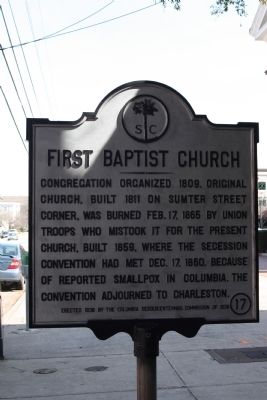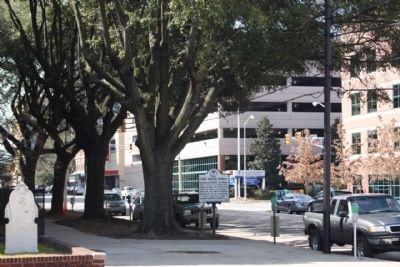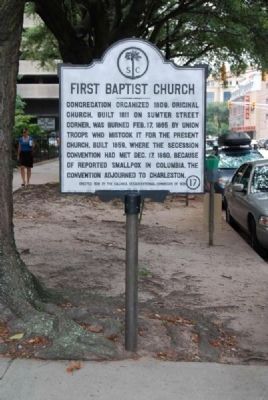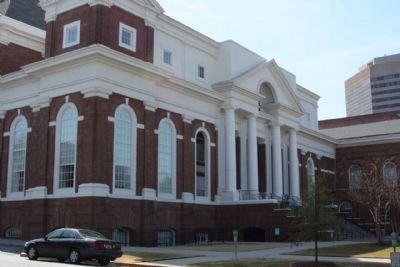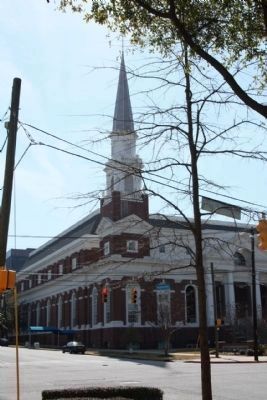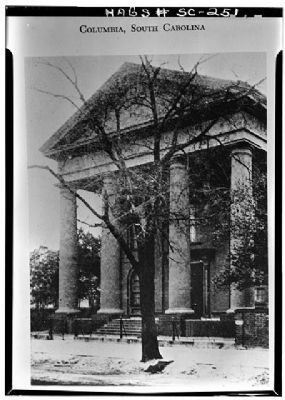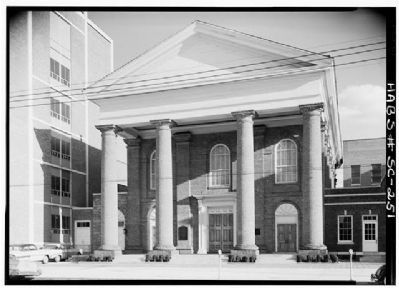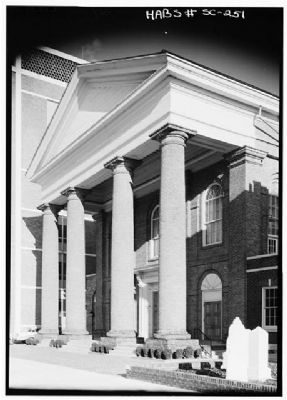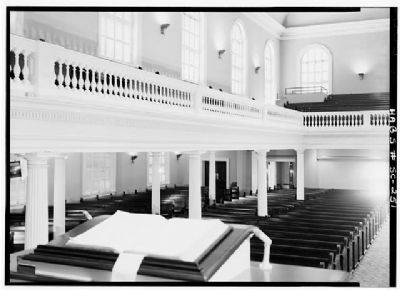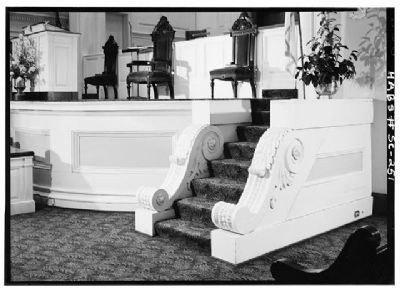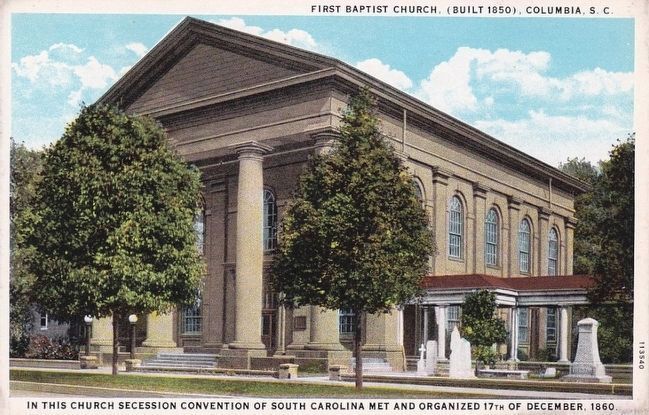Midtown - Downtown in Columbia in Richland County, South Carolina — The American South (South Atlantic)
First Baptist Church
Congregation organized 1809. Original church, built 1811 on Sumter Street corner, was burned Feb. 17, 1865 by Union troops who mistook it for the present church, built 1859, where the Secession Convention had met Dec. 17, 1860. Because of reported smallpox in Columbia, the convention adjourned to Charleston.
Erected 1938 by The Columbia Sesquicentennial Commission of 1936. (Marker Number 40-17.)
Topics and series. This historical marker is listed in this topic list: Churches & Religion. In addition, it is included in the National Historic Landmarks series list. A significant historical date for this entry is February 17, 1963.
Location. 34° 0.349′ N, 81° 1.996′ W. Marker is in Columbia, South Carolina, in Richland County. It is in Midtown - Downtown. Marker is on Hampton Street, on the right when traveling east. Located in the block between North Sumter Street and Marion Street. Touch for map. Marker is at or near this postal address: 1306 Hampton Street, Columbia SC 29201, United States of America. Touch for directions.
Other nearby markers. At least 10 other markers are within walking distance of this marker. Ordinance of Secession (a few steps from this marker); Site of Gibbes House (within shouting distance of this marker); Bethel A.M.E. Church (about 500 feet away, measured in a direct line); Site of Columbia Female Academy (about 500 feet away); Washington Street Methodist Church (about 500 feet away); a different marker also named Washington Street Methodist Church (about 500 feet away); Site of Columbia High School (about 500 feet away); Canal Dime Savings Bank/Bouie v. City of Columbia (1964) (about 700 feet away); 'We Kept the Fire Going' (about 700 feet away); We Shall Not Be Moved (about 700 feet away). Touch for a list and map of all markers in Columbia.
Regarding First Baptist Church. The First Baptist Church was the scene where the first southern state convention declared its separation from the United States of America. Delegates assembled here on December 17, 1860 and unanimously declared their intent that the State of South Carolina should secede from the Union. This act of separation, coming from a state of leading political prominence, carried an immediate momentum throughout the Gulf States and Georgia, inducing them to declare their own separation. Although the convention met for only one day at Columbia and signed the State’s Ordinance of Secession only after reassembling in Charleston, the intent
of the State’s political leaders was clearly and publicly declared at First Baptist. Erected in 1859, the church building features a Roman Tuscan portico and Tuscan pilasters down the sides, all rendered in molded brick. Alterations to the building occurred in 1941 and 1949. Listed in the National Register January 25, 1971; Designated a National Historic Landmark November 7, 1973. (South Carolina Department of Archives and History)
National Register of Historic Places:
First Baptist Church *** (added 1971 - - #71000800)
1306 Hampton St. , Columbia
♦ Historic Significance: Architecture/Engineering, Event
♦ Architect, builder, or engineer: Unknown
♦ Architectural Style: Greek Revival
♦ Area of Significance: Politics/Government, Architecture
♦ Period of Significance: 1850-1874
♦ Owner: Private
♦ Historic Function: Religion
♦ Historic Sub-function: Religious Structure
♦ Current Function: Religion
♦ Current Sub-function: Religious Structure
Also see . . .
1. First Baptist Church (Columbia, South Carolina). The First Baptist Church in Columbia, South Carolina is a Greek Revival building built in 1856. (Submitted on March 28, 2010, by Mike Stroud of Bluffton, South Carolina.)
2. First Baptist Church of Columbia. Official website of the First Baptist Church of Columbia. (Submitted on July 31, 2011, by Brian Scott of Anderson, South Carolina.)
3. First Baptist Church. The First Baptist Church was the scene where the first southern state convention declared its separation from the United States of America. Delegates assembled here on December 17, 1860 and unanimously declared their intent that the State of South Carolina should secede from the Union. (Submitted on July 31, 2011, by Brian Scott of Anderson, South Carolina.)
Additional commentary.
1. First Baptist Church - National Register Nomination Form (1973)
Description
The First Baptist Church building was erected in 1859 (architect unknown). The building has a Roman Tuscan portico and Tuscan pilasters down the sides, all rendered in molded brick. The building, before additions, was approximately 56' wide by 84' long, with balcony down each side and at the front over the entrance vestibule. In 1941 the rear wall was removed, pushed back, and the church extended 35'. At that time the proscenium arch was replaced with a rectangular proscenium of great width to allow for an adequate choir and baptistry. The original high pulpit and steps with carved volute flankers were retained and pushed back to the new location.
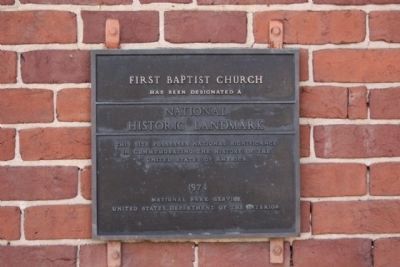
Photographed By Mike Stroud, February 21, 2010
4. First Baptist Church *** ( Building - #71000800)
Has Been Designated A
National Historic Landmark
This Site Possesses National Significance
In Commemorating The History Of The
United States Of America
1974
National Park Service
United States Department Of The Interior
The brick of the building was painted a dirty brown around the turn of the century. During the 1949 alterations this paint was carefully removed, exposing a range of colors from light tan to dark pink.
Significance
The First Baptist Church was the scene of the first southern state convention to declare its separating from the United States of America -- an act which ultimately led to civil war. The delegates assembled here on December 17, 1860, and unanimously declared their intent that the State of South Carolina should secede from the Union. This act of separation, coming from a State of leading political prominence, carried an immediate momentum throughout the Gulf States and Georgia, inducing them to declare their own separation. This momentum for secession was not unopposed. In every state convention outside South Carolina, a determined minority stood out for delay. Four states -- Arkansas, North Carolina, Virginia, and Tennessee did not make the break without the further inducement of the fall of Fort Sumter. The dilatory minorities
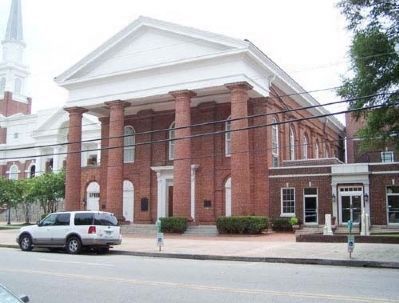
South Carolina Department of Archives and History
5. First Baptist Church
Until 1992, the actual building itself was used for services, which have been televised. The actual church itself is still used for other activities such as offices and a coffee shop connected to the church, but services in 1992 moved to a new building (at left) that is connected to the historic building as part of a building project that includes the new sanctuary
and the Estep Family Life Centre
Although the convention met for only one day at Columbia and signed the State's Ordinance of Secession only after reassembling in Charleston, the intent of the State's political leaders was clearly and publicly declared at the First Baptist Church in Columbia.
History
In the early part of the decade prior to the Civil War, the Compromise of 1850 emerged from the great debates designed to settle the question of slavery that divided the country. The Compromise seemed to be holding together and party leaders rigorously avoided talk of slavery, favoring discussion of industrial and territorial expansion. But hopes for sectional tranquility were fleeting. The Fugitive Slave Act played into the hands of northern antislavery radicals. Abolitionist reaction to the Act convinced many Southerns that northern public opinion was implacably hostile to their way of life. Southern proslavery "fire-eating" radicals were pleased by this turn of events which strengthened their secessionist influence. In both sections emotions began to outweigh reason and patience.
The Kansas-Nebraska Act shattered party alignments and led to severe political polarization of the great regions of the nation. The Act led to the emergence of truly sectional party allegiances. Following the election of 1856 it was clear that the new Republican Party could eventually capture the presidency against solid southern opposition. President Buchanan tried vainly to suppress the slavery issue. However, the American people would not be distracted. The Supreme Court offered no acceptable option and the Dred Scott decision fomented further estrangement of the sections. The Panic of 1857 stifled the Nation's prosperity which earlier served to mask the sectional controversy. The southern cotton market escaped the depression and Southerners began to believe that their economy was better off separated from the Nation.
In 1858, Republicans captured the House of Representatives and further obstructed Buchanan's policy of appeasement. In 1859 southern efforts to revive the international slave trade, coupled with John Brown's assault at Harper's Ferry, greatly inflamed animosities. Crisis followed crisis until, in the minds of many, the supreme test of the union would be the election of 1860. The Republican appeal was clearly sectional -- Lincoln's victory a minority
success. The question now was, would the South withdraw from the Union because of the election of a "black Republican."
The deep South answered yes. This time the secessionists were ready and organized. South Carolina, known for the prominent secessionist sympathies of many of its leaders, acted first. The legislature had remained in session throughout the national election and immediately afterward summoned a convention.
On Monday, December 17, 1860, the South Carolina Convention of the People met in the First Baptist Church in Columbia. The convention gave the chair to D.F. Jamison who stated the case for South Carolina and the rest of the seceding states as well as it was ever stated: He declared that the members of the convention were determined to cast off the yolk of the Federal Government and adopt new safeguards for their security. He warned his colleagues to be wary of conciliation and that efforts to preserve the Union would prove fruitless.
After a brief recess, the following resolution was moved -- "That it is the opinion of this Convention that the State of South Carolina should forthwith secede from the Federal Union, known as the United States of America." The delegates voted unanimously in favor of the resolution, 159 to 0. At the time, the smallpox was raging in Columbia and the convention voted to reassemble at Charleston. On December
20 the formal Ordinance of Secession was adopted unanimously and signed by the entire delegation.
— Submitted August 1, 2011, by Brian Scott of Anderson, South Carolina.
2. South Carolina Ordinance of Secession
At a Convention of the People of the State of South Carolina, begun and holden at Columbia on the Seventeenth day of December in the year or our Lord one thousand eight hundred and sixty and thence continued by adjournment to Charleston, and there by divers adjournments to the Twentieth day of December in the same year –
An Ordinance To dissolve the Union between the State of South Carolina and other States united with her under the compact entitled “The Constitution of the United States of America.”
We, the People of the State of South Carolina, in Convention assembled do declare and ordain, and it is herby declared and ordained, That the Ordinance adopted by us in Convention, on the twenty-third day of May in the year of our Lord One Thousand Seven hundred and eight eight, whereby the Constitution of the United State of America was ratified, and also all Acts and parts of Acts of the General Assembly of this State, ratifying amendment of the said Constitution, are here by repealed;
and that the union now subsisting between South Carolina and other States, under the name of “The United States of America,” is hereby dissolved.
Done at Charleston, the twentieth day of December, in the year of our Lord one thousand eight hundred and sixty
[signed] D.F. Jamison Delegate from Barnwell and President of the Convention
[signatures of delegates to the convention]
Attest: Benj. J. Arthur, Clerk of the Convention
— Submitted August 2, 2011, by Brian Scott of Anderson, South Carolina.
Credits. This page was last revised on February 16, 2023. It was originally submitted on March 28, 2010, by Mike Stroud of Bluffton, South Carolina. This page has been viewed 1,573 times since then and 36 times this year. Photos: 1, 2. submitted on March 28, 2010, by Mike Stroud of Bluffton, South Carolina. 3. submitted on July 31, 2011, by Brian Scott of Anderson, South Carolina. 4, 5, 6, 7. submitted on March 28, 2010, by Mike Stroud of Bluffton, South Carolina. 8, 9, 10, 11, 12. submitted on May 17, 2010, by Mike Stroud of Bluffton, South Carolina. 13. submitted on October 4, 2015. • Bill Pfingsten was the editor who published this page.
